
Barack Obama announced his running mate by text message. John McCain’s putting up YouTube videos. Mayoral candidates are doing robocalling. And just about everyone running for public office has a blog. Clearly, the campaign landscape has gone high-tech.
New technologies are helping candidates to connect with voters, and voters to connect with candidates, in new and surprising ways. And as a result, the practice of democracy itself is undergoing dramatic changes.
In the Political Web
The Web has become home base for politicians seeking to brand themselves. And political Web sites have often become entertainment-based as much as they are informational.
On Obama’s Web site, for example, visitors can access wallpapers, download ringtones and watch Barack TV, complete with its own lineup of channels. It’s an assortment of multimedia offerings unthinkable even 10 years ago, but it’s quickly become de rigueur to have a complete and ever-changing multimedia menu. Even McCain, who has at times been criticized for being behind the technology curve, has been directing much of his campaign communication through YouTube.
“Candidates are routinely publishing video clips on YouTube,” Seth Lieberman, CEO of Boston-based Pangea Media, told TechNewsWorld. “It’s very cost effective. It’s certainly not expensive to create a video for the Web.”
One of the benefits of using Web technologies is that they open up new possibilities for interactivity between candidates and voters. Lieberman can envision ways, for instance, that online quizzes — which have become a staple in the marketing world — might be used by political candidates. In essence, polls and quizzes are a way to gather and process information quickly and efficiently. And if they work for companies that manufacture sports drinks or blue jeans, they can work for politicians, as well.
“It’s hard to digest information from e-mails,” Lieberman told TechNewsWorld. “Polls and quizzes have a natural ability to aggregate data.”
Political candidates are also showing up in droves on Facebook, MySpace, LinkedIn, and other social networking sites. Social networking is an inherently political act, so it’s no surprise that politicians and political candidates are getting in on the social networking act.
“The biggest draw of using Internet and Web tools is the ability engage directly with voters,” Lieberman told TechNewsWorld. “Politicians can engage with voters in a way they never could even 10 years ago.”
Robocalling and Texting
It sounds like something from a cyborg film, but robocalling is actually a fairly established form of telemarketing, involving a computerized system for calling numbers and delivering a recorded message.
What’s new is that it’s being used increasingly by politicians to get in touch with potential voters.
“It is a low-cost, computerized way to get a message out to a constituency or a community,” Moses Ross, the owner of Oregon-based Political Robocalls, told TechNewsWorld. “It’s just like regular advertising — it’s all about name recognition and message.”
Robocalling’s even higher-tech cousin, mass text messaging, is coming into its own as well with the Obama campaign’s use of this technology. Obama supporters can sign up to receive ongoing general text messages, as well as messages tailored to issues like healthcare. Ross sees this as one of the most revolutionary new means of communication that is available to candidates now.
“All of a sudden he has direct communication with young people nationwide,” Ross said of Obama’s texting.
Sorting Out the Vote
On the more mundane, backdoor side of things, technology is also affecting the way candidates gather, store and process information that they use to campaign. Increasingly, candidates at all levels of the political world are turning to software geared toward making the process simpler and more effective.
Iowa-based AdTrack, for instance, offers a product called “SmartVote,” which is a Web-based targeting tool to manage voter files and target voters through grassroots methods.
“Our clients like the blend of advanced technology with grassroots methods to target voters,” AdTrack’s product manager Ben Rogers told TechNewsWorld. “It’s a one-stop shop.”
Rogers himself is running for the Linn County, Iowa, Board of Supervisors this fall, and he’s using SmartVote to target potential voters and plan his campaign strategy.
“I’m targeting them with specifically tailored messages, and SmartVote lets me target and contact them,” Rogers told TechNewsWorld. “I know who I need to talk to. With SmartVote, you can go as granular as street level.”
And SmartVote also has plans to incorporate new technologies for voter and demographic analysis as they develop.
“SmartVote is continually improving our technology platform,” Rogers told TechNewsWorld. “Because SmartVote is built on a customizable platform, we have the ability to integrate new technologies.”





















































